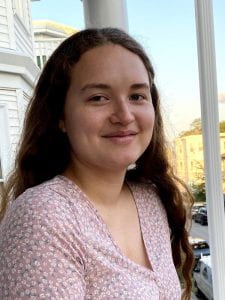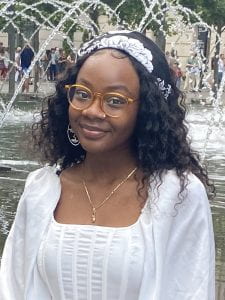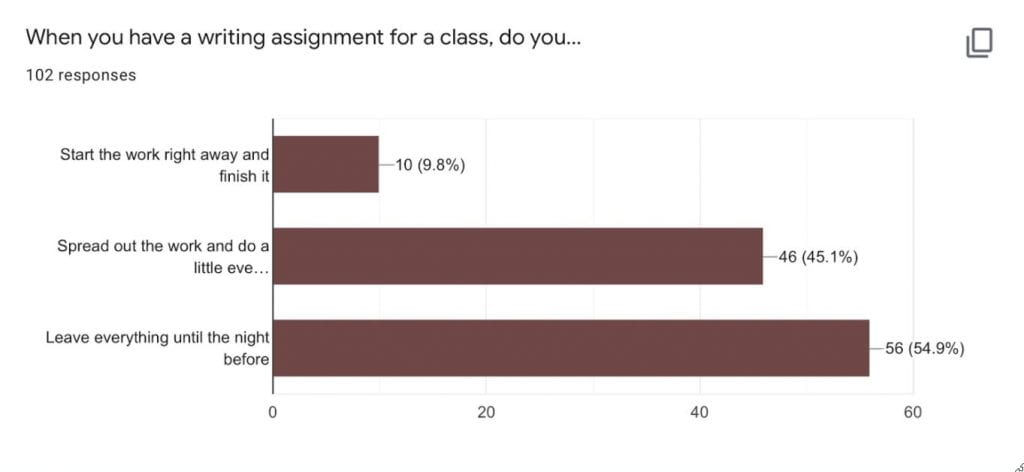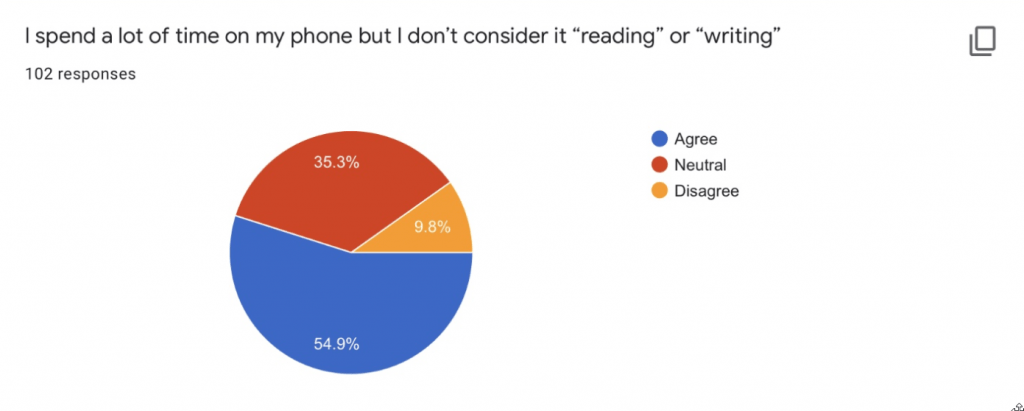by Hannah Ortiz

Hannah Ortiz is an English major with a Professional & New Media Writing concentration, and is from Hartford, Connecticut. Because she is studying reading and writing, Hannah feels that the censorship of literature is an important topic. Hannah says “I love reading and I believe that people, especially children, should be able to read books that teach us about the world.” She states that we do not have to agree with every book we read, but that “literature can present different perspectives that can educate us about messages we don’t agree with.” Hannah believes that biased literature has been some of the most impactful as it has taught us about the world, and that these books make statements about the world that will last into the future. She also feels that “studying English requires an understanding of how our culture has influenced us. This influence cannot be denied.” Hannah is passionate about non-profit work and community organization: “non-profit organizations address community needs that are often overlooked.” She also writes poetry and her first mini-chapbook was published this summer.
In a segment on the television show 60 Minutes titled, “Born Good? Babies Help Unlock the Origins of Morality,” Yale University’s Baby Lab puts infants to the test. Using puppets to portray simple dilemmas, scientists attempt to determine if babies can make moral determinations. Reporter Leslie Stahl asks psychologist Paul Bloom how humans become moral. Stahl recounts, “He [Bloom] says it makes sense that evolution would predispose us to be wary of ‘the other’ for survival, and so we need society and parental nurturing to intervene.” Neither Stahl or Bloom answer how society can assist in helping children learn about moral standards. But as children spend a significant amount of time in school, it can be assumed that the educational institutions they attend further their moral development. Children learn how to develop psychosocial skills from their environment, including the reading material they consume in school. Just as this literature can assist in developing morality, many worry that biased literature (literature written with a discriminatory basis or that portrays discrimination) can impair young minds with immorality. However, controversial literature does not have to be discarded or censored in the interest of developing children’s morals. Instead, this literature should be repurposed and utilized for anti-bias education.
To rebuke the censorship of literature for children, one needs to understand the motivations behind this censorship. Society as a whole operates under the perception that children are innocent and need to be protected from the evils of the world. As a result, advocates for children, including parents, seek to limit the exposure of children to controversial literature. It is believed that this literature can spark immoral ideas in its readers’ minds. The censorship is often done with good intentions. A book from Marjorie Heins titled Not in Front of the Children: Indecency, Censorship, and the Innocence of Youth explores the censorship of art and media, and why advocates feel as though children should be shielded from violence and sexuality. Heins states, “Evidence of harm, of course, is often dispensed with in censorship cases where child protection is the proffered justification … it was not really fear of any demonstrable psychological harm, but notions of morality and proper socialization that drove … legal rhetoric.” (Heins 255) Child advocates attempt to prove that cultural influences, such as media violence, drive the youth to act violently. These advocates cannot verify, through studies or other inquiries, that their theories are true, and that art is to blame for an increase in immorality. The correlation is nonexistent, but the fear and the connection remain (255). Advocates believe that children need to be protected from the immortality of the world so that they will not mimic it or suffer damage from it. It is easy to understand why advocates believe that books about racism might fuel racist thinking, or books containing sexist slurs might fuel sexism.
Historically, parents have pursued legal action against educational institutions that share discriminatory literature with their students. The book Censorship and Selection: Issues and Answers for Schools by Henry Reichman and the American Library Association (ALA) reviews statistics and cases connected to literary censorship across the United States. For example, in 1999, an Arizona mother sued a school district for including Huckleberry Finn and “A Rose for Emily” by William Faulkner on the high school reading list. Kathy Montero alleged that “white students were harassing blacks … Monteiro charged that white students called her daughter and others ‘n—–‘ and that assignment of the Twain and Faulkner readings, which use the word, exacerbated the situation” (Reichman 77). The Monteiro v. Tempe Union High School District case proves that the parents that call for censorship are not calling for action solely on the basis of religious beliefs or ignorance. In the case of Monteiro v. Tempe, Kathy Montero was seriously concerned about the well-being of her daughter and other black students (77). Parents wonder, and worry, how literature will be interpreted and utilized by their children. Words have power, and they have the power to influence morality, especially at a young age. But if biased literature, like the works of Twain and Faulkner are correctly introduced to students, this will transform the contexts of these works and allow students to learn positive, moral lessons from them.
Utilizing biased books in anti-bias education gives children the opportunity to challenge biased beliefs and perceptions, comparing them to their own understanding of the world. Biased literature can give children the opportunity to challenge what they read, which is an important skill to develop as one continues to consume media. Selection, as opposed to censorship, will ensure that the exploration of controversial texts results in beneficial education about media skepticism. Gillian Klein recommends selection over censorship in her book Reading into Racism: Bias in Children’s Literature and Learning Materials. Klein writes that the most effective and lasting strategy for combating racism and sexism and other damaging bias in books is to teach children to challenge everything they read. “They are developing approaches to combating the effects of biased books in the schools and teaching children to challenge the authority of the printed word and to trust in their own judgment” (Klein 141). Students need to learn to doubt the messages of the media and to develop and ultimately to trust their own judgment. Examining the validity of a source is an important skill. If adults are told not to believe everything they read, why can’t children learn to differentiate between truthful and biased information? Reading Into Racism declares, “learning to read usually involves a verification of what is read … If this process is not checked, the result is adults who believe everything they read—or read only what they wish to believe, choosing their daily newspaper, for instance, accordingly” (Klein 114-115). A failure to challenge the media has long-term effects on one’s morality. If one never sees truth in statements that do not align with their own beliefs or knowledge, they will never learn anything about the world. If one upholds all news sources as authority, they will never be able to make their own judgments, and they may be susceptible to believing untruths. Children who are taught to challenge biased literature will gain the skill of media skepticism and interpretation. This is dependent on the exposure, not the censorship, of biased literature for the purpose of anti-bias education.
Another benefit of utilizing “controversial” literature for anti-bias education is that it teaches children about social issues that they otherwise would not understand. These books can help children gain a better understanding of nuanced social phenomena such as racism, sexism, and poverty. Parents and advocates have often called for the censorship of books that introduce students to social injustice. But Censorship and Selection denies that these works should be censored: “Racial, sexual, and other prejudices are part of our country’s history and of its present reality. The school library will necessarily reflect this, which is not wholly a bad thing since students can hardly be taught to identify and reject prejudicial thought without directly confronting examples of bias and stereotyping” (Reichman 73). Acknowledging prejudice is a momentous event in the human experience, whether or not one is interested in addressing their prejudices. Removing books that mention prejudice will not remove prejudice from the world, and students may already be affected by prejudice, even if they do not recognize it. Instead of ignoring social inequalities, students can have the opportunity to address them through their exposure to literature.
Censoring biased literature or literature that details biases has the potential to assign value to biases. If controversial books are separated from the other literature in a school library, this may attach importance to the works. “’Not Censorship but Selection’: Censorship and/as Prizing” is an article from Kenneth Kidd likening censorship to “literary prizing.” While censorship is typically seen as a negative action, censoring literature can make the literature seem more important to children. Censorship makes these texts appear relevant, even when parents argue against this judgment. Kidd says, “Censorship clarifies what is and what isn’t legitimate in a culture, leading to further debate about worth and often transforming the original standards and expectations” (Kidd 198). Advocates should reflect on their childhood experiences, especially what they considered to be stimulating. Censored literature is comparable to a box in a mother’s closet that she tells her child not to open. Wouldn’t a child hypothesize about that box and believe that it had something life-changing inside? Similarly, a country’s leader could censor a book detailing the crimes of their regime. If the leader suppresses this knowledge, wouldn’t their constituents then wonder if there is truth in the pages? Kidd adds, “…obscenity laws and other mechanisms for censorship ironically have helped enshrine certain materials as literature” (Kidd 198). Books previously labeled as “too obscene” are now considered classics. As society’s morals shift, work that was deemed too explicit is now respected, defeating the purpose of censorship. Again, censored literature is comparable to the words of civil rights activists. While their words were often seen as flagrant, society’s morals shifted; these activists are now revered as heroes. Censoring biased literature will attract interest without context. It is better for educators to explore this literature with their students so that interest and validation is diverted into literary interpretation and moral development.
Censoring biased literature teaches children to act with an authoritarian basis as opposed to a democratic one. Censoring literature sets the precedent that controversial issues or content should be censored as opposed to acknowledged. If all controversial ideas were censored, society would fail to progress. Societal and moral development is dependent on inquiries and solutions, debates, and engagement. Stifling ideas and words will only obstruct communication and change. Heins asserts in Not in Front of the Children, “Intellectual protectionism frustrates rather than enhances young people’s mental agility and capacity to deal with the world … censorship may also have ‘modeling effects,’ teaching authoritarianism, intolerance for unpopular opinions, erotophobia, and sexual guilt” (Heins 257). Besides preventing youth from developing a better understanding of life, censorship furthers the idea that knowledge deserves to be stifled. This mentality can grow toxic: if teachers can censor books, why can’t students censor each other in the classroom? If a student hears an idea that challenges them, what is stopping them from censoring any mention of this idea? The American Library Association agrees that censorship endangers intellectual freedom. Reichman notes, “Removing a book from a classroom or school library because it offends some members of the community increases the likelihood that students will see suppression as an acceptable way of responding to controversial ideals and images” (Reichman 4) Removal of potentially offensive literature defies the morals of tolerance and inclusion that schools attempt to instill in students. If educators disagree with the messages in this literature, they have the opportunity to discuss why these biases are harmful through anti-bias education. Simply ignoring the problems in these works does not allow space for critical thinking and prohibits moral development.
Parents and advocates mistakenly believe that children enter the world, and the classroom, as blank slates without moral perspectives. But psychologists like Paul Bloom have proven that the world only shapes morality; it does not create it (“Born Good? Babies Help Unlock the Origins of Morality”). Literature written by discriminatory authors or containing discriminatory aspects should not be removed from classrooms or school libraries. This literature serves its purposes in teaching students about social issues and assisting in moral development. It also teaches students to view literary work with a critical eye. Censoring literature only holds this work to a different, heightened standard, and discourages students from considering different perspectives. Resources like Reading into Racism inform educators how to handle biased books. One activity Klein suggests is having students write letters to publishers who have released racist books (not books about racism), inquiring about the motivations behind racist content (Klein 132). This encourages students to advocate for themselves and consider why a text may have been written. The most important lesson Klein shares is this: “Teachers need to recognize their responsibility as agents between their pupils and the books: they are automatically endorsing the materials with their own implicit approval unless they specifically say otherwise and indicate the passages with which they disagree” (112). With the correct educational intervention, biased or controversial literature can be read and discussed, furthering the moral development of every person in the classroom.
Works Cited
“Born Good? Babies Help Unlock the Origins of Morality.” YouTube, CBS News Online, 18 Nov. 2012, www.youtube.com/watch?v=FRvVFW85IcU.
Heins, Marjorie. Not in Front of the Children: “Indecency,” Censorship, and the Innocence of Youth. Rutgers University Press, 2007.
Kidd, Kenneth. “‘Not Censorship but Selection’: Censorship And/as Prizing.” Children’s Literature in Education, vol. 40, no. 3, Springer, 2009, pp. 197–216.
Klein, Gillian. Reading into Racism: Bias in Children’s Literature and Learning Materials, Taylor & Francis Group, 1985.
Reichman, Henry, and American Library Association. Censorship and Selection: Issues and Answers for Schools, ALA Editions, 2000.













